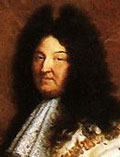 |
Louis XIV
b. 5 Sep 1638, Saint-Germain-en-Laye
d. 1 Sep 1715, Versailles |
| Title: |
Par la grâce de Dieu, Roi de France et de Navarre = Dei Gratia Francorum et Navarrae Rex (By the Grace of God, King of France and Navarre) |
| Term: |
14 May 1643 - 1 Sep 1715 |
| Chronology: |
14 May 1643,
succeeded to the throne [1] |
|
18 May 1643, regency of the Queen Mother (Anne of Austria) formally commenced; royal lit de justice announced at the session of the Parlement of Paris (installation of Regency proclaimed by an act of the Parlement of Paris 18 May 1643) [2] |
|
7 Sep 1651, period of Regency formally ended; royal lit de justice announced to the representatives of the Parlement of Paris, Sainte-Chapelle, Paris [3] |
|
7 Jun 1654, consecrated and crowned, Notre-Dame Cathedral, Reims |
|
1 Sep 1715, died [4] |
| Names/titles: |
Private name: Loius-Dieudonné de France; Premier fils de France et dauphin de Viennois (First Son of France and Dauphin of Viennois) [from 5 Sep 1638]; comte de Barcelona (count of Barcelona) [14 May 1643 - 18 Jan 1653]; duc de Luxembourg (duke of Luxembourg) [4 Jun 1684 - 20 Sep 1697]; bynames: le Roi Soleil (the Sun King), le Grand (the Great) |
| Biography: |
| Son of King Louis XIII and Infanta Ana Mauricia de Austria (French: Anne-Maurice, commonly known as Anne of Austria), daughter of king Felipe III of Spain; succeeded his father (14 May 1643); governed under the regency of his mother (1643-1651), relying on principal minister Cardinal Jules Mazarin (Giulio Raimondo Mazzarini); survived a long civil war (the Fronde) (1648-1653) fought by the nobles against the crown and Mazarin; finally assumed the reins of power after the death of Mazarin (9 Mar 1661); was backed up first by a group of powerful ministers (Jean-Baptiste Colbert, the Marquis de Louvois, Hugues de Lionne); ruled effectively, closely supervising the state affairs; laid foundation for the regime of absolute monarchy in France; married (3 Jun 1660) Infanta Maria Teresa de Austria (French: Marie-Thérèse), daughter of king Felipe IV of Spain; unsuccessfully invaded the Spanish Netherlands (1667-1668), which he regarded as his wife's inheritance; resumed the war against the Netherlands (1672), ending with the first Treaty of Nijmegen (1678); defeated the coalition of Spain, Holy Roman emperor and the Dutch; extended the boundary of France by annexing part of Flanders and by seizing Lorraine and the Franche-Comté (1678); extended the patronage of arts; transferred the seat of government to Versailles (1682) built to enhance French prestige; revoked (1685) the Edict of Nantes, which had guaranteed freedom of worship for the Protestants; entered the war against the Grand Alliance (England, the Dutch, and the Emperor) (1688-1697); despite many victories, gave up part of his territorial acquisitions when he signed the Treaty of Rijswijk; accepted the Spanish inheritance, following the death of Carlos II (1700), the last Habsburg king of Spain, who bequeathing his kingdoms to Louis's grandson, Philip of Anjou (future Felipe V of Spain); fought the War of the Spanish Succession, where the anti-French alliance reactivated by King William III of England brought France close to losing (1709) all the advantages gained over the preceding century; a palace revolution in London, bringing the pacific Tories to power, and a French victory over the imperial forces at the Battle of Denain combined to end the war; agreed to signing the treaties of Utrecht, Rastatt, and Baden (1713-1714), which cost France its hegemony but left its territory intact; retained the conquests in Flanders and on the Rhine. |
| Biographical sources: "Louis XIV", by Jacques Roujon (Paris: Éditions du Livre moderne, 1943); "Louis XIV", by Philippe Erlanger (Paris: Fayard, 1965); "Louis XIV", by John B. Wolf (New York: Norton, 1968). |
| |
| [1] |
Recueil général des anciennes lois françaises, 17:1-2. |
| [2] |
Recueil général des anciennes lois françaises, 17:2-13. |
| [3] |
Recueil général des anciennes lois françaises, 17:258-260. |
| [4] |
La Gazette, No. 36, 7 Sep 1715, p. 431. |
|
Image: detail of a portrait by Hyacinthe Rigaud, 1694. |